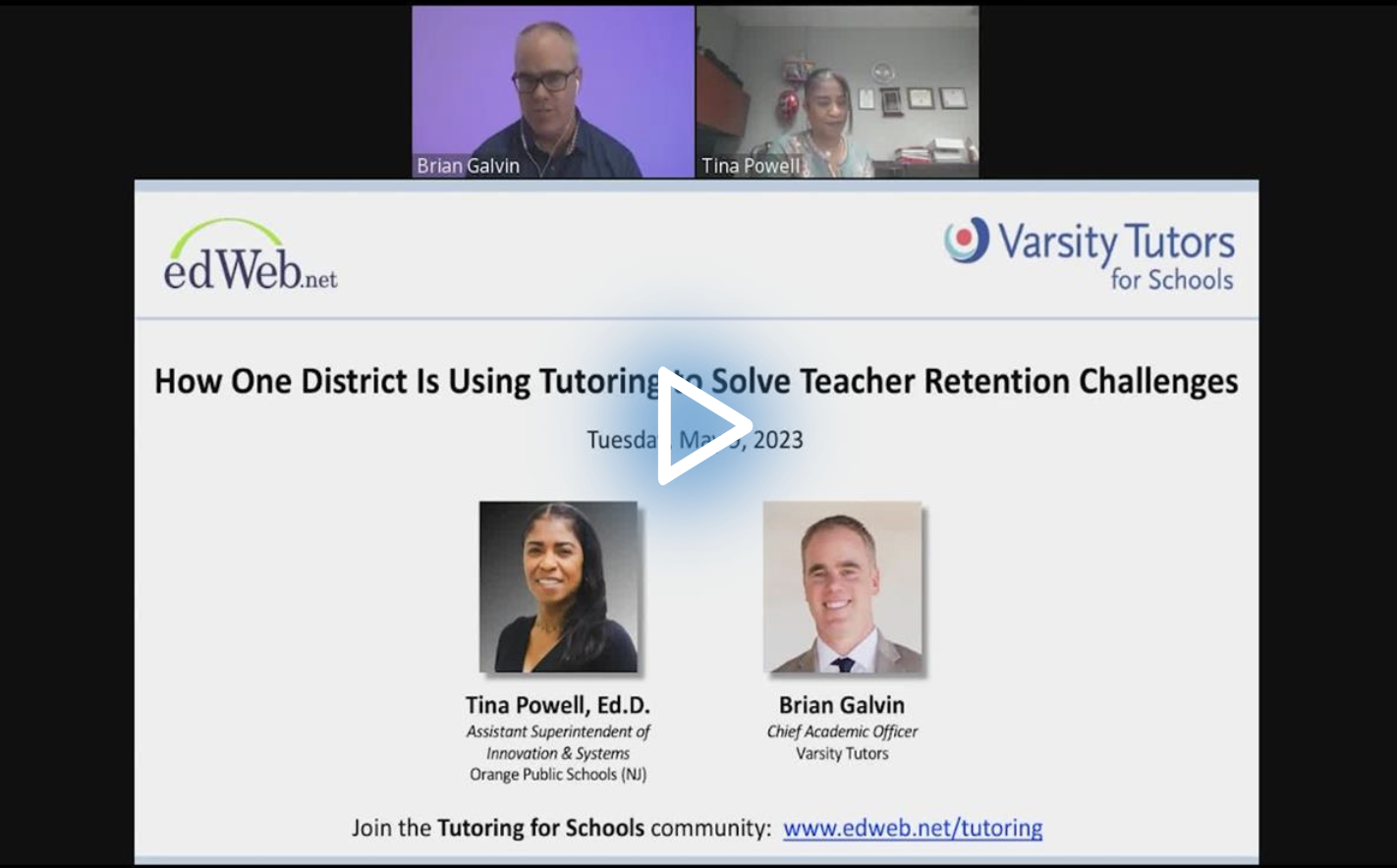High-Dosage Tutoring: Supporting Students and Keeping Teachers
Watch the Recording Listen to the Podcast
Tutoring, it turns out, not only boosts student achievement but also heightens teacher retention, a discovery made by Dr. Tina Powell, Orange Public Schools (NJ) Assistant Superintendent of Innovation and Systems, when her district explored solutions to post-pandemic unfinished learning.
In the edLeader Panel “How One District is Using Tutoring to Solve Teacher Retention Challenges,” Dr. Powell described methods the district used to leverage tutoring, in partnership with Varsity Tutors, to alleviate teachers’ workloads while supporting students with personalized standards-aligned instruction.
A Balancing Act
Students in Orange Public Schools, like most students across the country, experienced interrupted learning during COVID-19, placing greater demands on them and their teachers. The challenge was addressing this unfinished learning with a dwindling teaching force.
As a result, the district implemented as many strategies as possible to support students. For example, teachers covered classes; scheduling was revisited to absorb vacancies, a move, unfortunately, that created a new burden—increased class sizes. The solutions sadly heightened teacher burnout and attrition.
The district recognized that a refined, strategic approach was necessary to support its teachers and students. This thinking led to a multi-step design and development process resulting in a successful high-dosage tutoring initiative.
Orange Public Schools’ efforts can serve as a model for schools and districts seeking to address learning and instructional needs.
The Process
Step 1: Identify the Problem
Dr. Powell described how the district discovered large vacancies among its hard-to-fill segments districtwide.
“We experienced quite a few vacancies within the last few school years,” she explained. “Pre-pandemic, we typically kept our vacancy percentages and rates below 5%. At this point, we’re at roughly 6% of vacancies throughout the district. We have about 850 teachers, so do the math on that; it gives you an indication of the need to fill those vacancies.”
The district asked essential questions to address unfinished learning and teacher retention: What contributes to teacher burnout, attrition, and retention challenges? What can a district address, and what is beyond its capacity to resolve?
Step 2: Assessing and Addressing Teacher Preferences
Orange Public Schools identified and implemented the following measures to assess and address teachers’ needs, concerns, and desires during and after the pandemic.
- Establishing more social-emotional learning practices for staff and students
- Engaging teachers in curricula writing and development alongside district staff
- Providing ongoing opportunities for teachers to share their input and feedback on instructional matters
- Administering surveys to get a pulse on how staff felt about the pandemic’s impact and other matters to help inform district decisions
- Revisiting scheduling to enable staff to leave school earlier to spend time with their families
- Promoting safety during the pandemic (social distancing, disinfecting, etc.), mainly to ease teacher concerns about the health of immunocompromised family members
- Recognizing post-pandemic staff burnout, fatigue, and the degree of unfinished and interrupted learning, which the existing curriculum could not fully address. To support teachers, the district implemented more creative and flexible planning, intervention opportunities, etc.
They also rewarded and engaged teachers in other ways, such as running recognition ceremonies, offering a Teacher Appreciation Week luncheon, and giving them voice and choice, all to demonstrate appreciation for and heighten teachers’ expertise, satisfaction, and retention.
This happened while the district continued intensively exploring how to support teachers and students.
Step 3: Sizing Up Student Needs
To more intentionally identify student needs and learning gaps, the district administered diagnostic assessments across its schools that ultimately told the story of learning: There was an increase in the number of students who were one, two, and three grade levels behind in English and math, indicating they may not have had the supports they desperately needed.
Step 4: Using Data to Inform and Drive Decisions
Dr. Powell said the district is deliberate about the data it seeks, asking hard questions. One crucial question was what the pandemic’s impact was, specifically on learning.
“Plenty of research studies and reports, the big one from NWEA, spoke to the degree of learning loss across the states, and we were on it,” she said. “We were looking at those comparative results. Our last state assessment prior to the pandemic was during the 2018-2019 school year. We had been trending up with our results and wanted to see the overall impact of the pandemic. And not just so-called post-pandemic, but during.”
The district calculated unfinished learning during the summer to estimate how COVID-19 would impede learning.
With roughly 80% of the district’s students considered economically disadvantaged, 14% with special needs, and 20% English language learners, many students, explained Dr. Powell, are already somewhat disconnected from education, making it necessary to provide support to ensure that these students don’t fall further behind.
Step 5. Researching, Piloting, and Implementing Solutions
With data in hand, Orange Public Schools developed clear ideas for addressing student and teacher support. In addition, thanks to COVID-19 relief dollars, the district had the financial means to undertake creative programming.
It explored models, one of which was high-dosage personalized and individualized tutoring in an interventional and general school environment and within contexts where tutoring would not be accessible.
The district also considered teacher support in terms of retention, revisiting an earlier blended learning model—which allowed students to rotate to technology centers for learning support—to design a more personalized learning approach, with which the tutoring model ultimately meshed.
The district used data to identify students in grades two through seven who needed support and for whom gap-closing strategies were developed and piloted after school. Parents had a role in the tutoring, selecting the subjects they felt their children needed help with.
Step 6: Analysis and Restructuring
Post-pilot, the district assessed its efforts to make necessary project improvements. A significant change was offering tutoring during the school day. After school proved inconsistent, affecting how learners progressed and interacted with their virtual tutors.
Restructuring involved selecting 200 students to participate in a second pilot. The students were one, two, and three grade levels behind, and required ELA and math support. The district used Lexile scores for ELA, a combination of grade-level equivalents and percentile to identify those students for math, and teacher input regarding whom would be best served through personalized tutoring.
Before the pilot rollout at the start of the school year, students were pretested to ensure ideal tutor-student matches. Students were scheduled to have tutoring sessions two days per week. The program design was incorporated into a personalized learning model.
Step 7: Monitor and Record Success and Impact
The tutoring initiative has generated positive results, which include the following:
- Pre-identified students were multiple grade levels below their typically developing peers. Tutoring enabled the district to exit many of them from interventions because they reached grade-level readiness.
- Teachers are pleased with the additional support tutoring provided. More teachers are in the driver’s seat during tutoring, sharing lessons with the tutor and connecting the dots between the classroom and what occurs during tutoring.
- There has been reduced teacher attrition, and the district has filled multiple vacancies.
- Tutoring is often directly aligned with instructional and curricular content.
- Students are fully engaged during the session, freeing teachers from redirecting instruction. And students enjoy meeting with their virtual tutors.
Orange Public Schools continues to use tutoring to ease the burden on educators by empowering them with extra hands to support students in academic need and to keep teachers professionally satisfied and in school. It’s been a win-win to date.
“We’re making strides,” said Dr. Powell. “We’re making strides.”
Learn more about this edWeb broadcast, “How One District is Using Tutoring to Solve Teacher Retention Challenges,” sponsored by Varsity Tutors.
Watch the Recording Listen to the Podcast
Join the Community
Tutoring for Schools is a free professional learning community that supports tutors, teachers, and district administrators using personalized learning tools in the classroom.
Varsity Tutors for Schools is your all-in-one live learning platform that delivers personalized learning to every student in your school district. Whatever challenges your students face, our proven solutions can be customized to meet their needs, providing equitable access to everything from on-demand to 1-on-1 high-impact tutoring to adaptive assessments.
Blog post by Michele Israel, based on this edLeader Panel






Comments are closed.